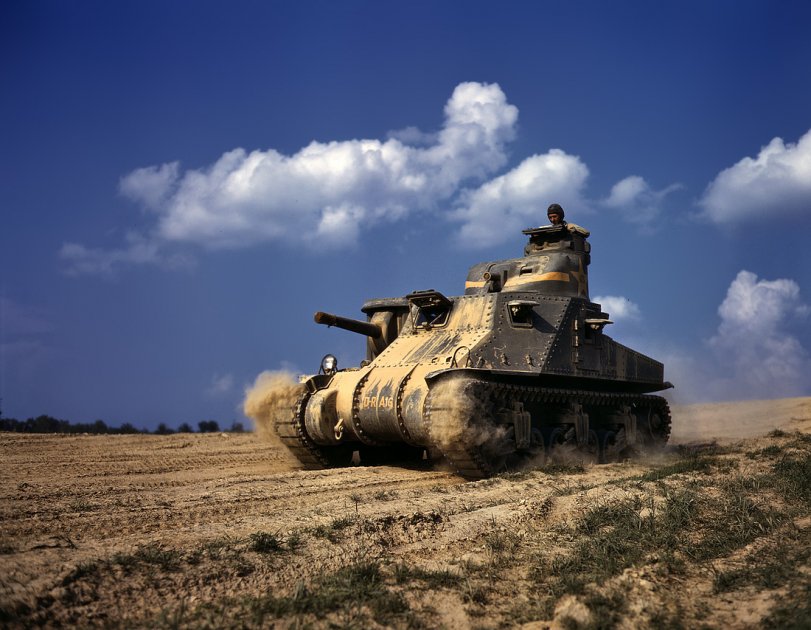


Framed or unframed, desk size to sofa size, printed by us in Arizona and Alabama since 2007. Explore now.
Shorpy is funded by you. Patreon contributors get an ad-free experience.
Learn more.

- Tough Guys
- Lost in Toyland
- And without gloves
- If I were a blindfolded time traveler
- Smoke Consumer Also Cooks
- Oh that stove!
- Possibly still there?
- What?!?
- $100 Reward
- Freeze Frame
- Texas Flyer wanted
- Just a Year Too Soon
- WWII -- Replacing men with women at the railroad crossing.
- Yes, Icing
- You kids drive me nuts!
- NOT An Easy Job
- I wonder
- Just add window boxes
- Icing Platform?
- Indiana Harbor Belt abides
- Freezing haze
- Corrections (for those who care)
- C&NW at Nelson
- Fallen Flags
- A dangerous job made worse
- Water Stop
- Passenger trains have right of way over freights?
- Coal
- Never ceases to amaze me.
- Still chuggin' (in model form)
Print Emporium
Fort Knox: 1942

June 1942. M-3 tank in action at Fort Knox, Kentucky. View full size. 4x5 Kodachrome transparency by Alfred Palmer, Office of War Information.
The Tank
As far as Central Harlem Anonymous's question as to whether "this tank would have seemed impressive or threatening to viewers of this photograph in 1942," the answer is that to the uninformed viewer it would have seemed quite impressive, but to anyone who had much knowledge about armor it would not be well regarded at all. The M-3 - known to the British as the General Lee - was pretty much obsolescent when it came off the production line. The 75 mm main gun is impressive enough but it is mounted in a sponson on the right side of the tank's hull giving it a limited field of fire of about 15 degrees to the right or left of center. The secondary gun, a 37 mm turret mounted gun (in this tank either removed, not mounted or cut off) was a fairly decent gun but didn't have the striking power of the guns that even the German Panzer IV had. And that was weak compared to what the Tiger Tanks that the Germans were producing had. The turret itself is a disaster - far too high and a very inviting target. The British bought a large number of the M-3s to cover their own shortfalls in tank production and the first thing they did was to replace the turret with a lower one of their own design. The result was the "General Grant" which was one of the main tanks of Montgomery's Eighth Army at the Battle of El Alamein. The Grants and Lees were taken out of service by the time of the invasion of Sicily, though some were used by the British in the Burma theater of operations where the Japanese tanks were truly pathetic. The Russians were given some through Lend-Lease; they referred to the Lee as "a coffin for seven brothers." Of course by this time the Russians were operating the beautiful T-34. The US Army would eventually use the body of the M-3, heavily modified, to create a self propelled gun type, the M-7 Priest.
Central Harlem's Uniformed Question
In 1942 Kodachrome had a film speed of Weston 8 which corresponded EXACTLY to ASA 10, which corresponds exactly to ISO 10. There is no reason to believe that Kodachrome would have suffered any color deterioration WHATEVER since this image was processed and stored in 1942, so the colors you see here are probably exceedingly close to what you they were in 1942, allowing for the vagaries of present-day scanning, conversion to digital electronic format, and display. The colors as presented here are typical of what can be seen from properly stored Kodachrome transparencies from the 1940s, perhaps originally exposed through a polarizer, though not necessarily. Consult the Wikipedia article on Kodachrome for more on all this.
[So, what kind of uniform does a "uniformed" question wear? Dress blues? Irritating, obtuse comment of the day. But the day is young! - Dave]
A triumph for democracy, and for Kodachrome
Team Shorpy - Any chance of our seeing what this image looked like before color correction?
This is a great shot, and I am intrigued by the conditions under which it was taken. I do not think color films in 1942 were very quick; this was probably shot on what would today be called iso 25 or iso 50 film. However, the dust clouds and tank treads are frozen, so the shutter speed may have been 1/250 or even faster. Palmer got pretty good depth of field too -- several feet at least. That combination suggests that this photo was taken in very bright sunlight.
Traditionally, such a dark blue sky suggests that a polarizing filter was used, but that would have cut down on light and Palmer needed all the light he could get for this shot. Was it enhanced in Photoshop?
I wonder if this tank would have seemed impressive or threatening to viewers of this photograph in 1942. To my eye, it looks cute, but perhaps that's the result of decades of exposure to much larger and more dangerous machines.
[Original image below. - Dave]

























On Shorpy:
Today’s Top 5